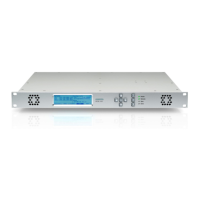RCS User Manual
18
Window size: It defines the duration of the window analysis (in seconds) to detect black/frozen
images. By increasing this value, more robust the algorithm will be. The minimum recommended
value is 5 seconds.
Uniform variation analysis and Small packet analysis: These two parameters define the algorithm's
behaviour. You can switch on/off any of them to adjust the algorithm's performance to the video
source type. For instance, "Uniform variation analysis" is recommended for video sources generated
by FFMPEG tools.
See section 1.5.1.- Alarms Profiles. The Black and Freeze alarms are configured in the Services
alarms profiles.
Audio Silence Settings: Allows to set the parameter needed to detect the audio silences events
(only for RCS100 and RCS400 with the option 902568). This parameter is:
Window size: It defines the duration of the window analysis (in seconds) to detect audio silence. If
the RCS detects that there is no sound during a time interval equal to Window size, the
corresponding alarm will be activated.
See section 1.5.1.- Alarms Profiles. The Audio Silence alarms are configured in the Services alarms
profiles.
TS Recording: The files of the TS recordings can be saved in the internal memory of the RCS, or in
a pen drive connected to the RCS. This option is available only when the RCS detects a pen drive.
In addition, the user must indicate the time he wants to record before (between 1 and 15 seconds)
and after (between 15 and 45 seconds) the event.
Date and Time: When you first open the web application, you must set the date, the hour, the
region and the zone of the system, so the data will be saved correctly.
Units: You can choose the units to use in your measurements, dBuV or dBm.
Field Strength: This measurement can be enabled or disabled. When it is enabled, it requires to
characterize the antenna for wich the measurement is done. To do this, you must upload a file that
indicates the K factor and the gain of the antenna for a frequency range. This file must be a .csv file
with the following structure: 3 columns: the first column with the frequency values (in MHz), the
second column with the gain of the antenna for that frequency (in dB), and the third one with the K
factor for that frequency. It is also necessary to indicate the offset, that is a correction factor applied
to all the frequencies to offset the gain or loss that the signal has from the antenna to the RCS input.
So, the offset may be positive (when there are gain) or negative (when there are loss).
Numeric Format: You can choose the PIDs view mode (hexadecimal/decimal) as well.
DVB-T2 SFN Sync Mode: Allows to choose Manual or Auto SFN synchronization. See section 5.5.-
SFN.
Warning: The setup parameters must be handled by an expert. An arbitrary
change may cause problems in the system.

